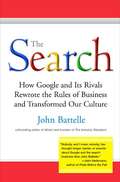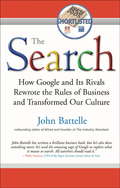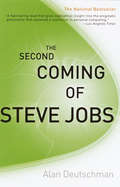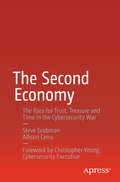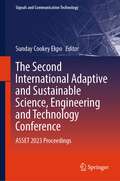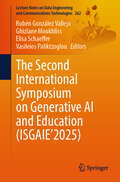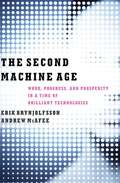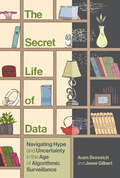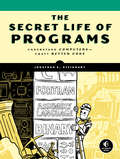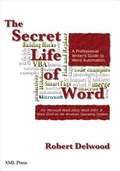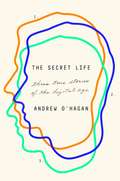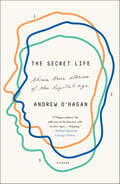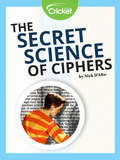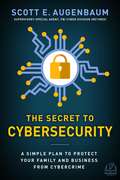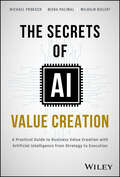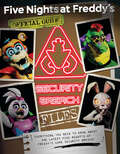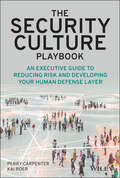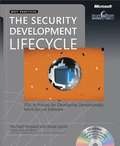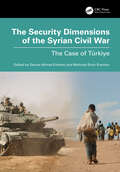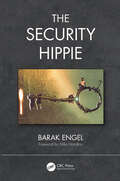- Table View
- List View
The Search: How Google and Its Rivals Rewrote the Rules
by John Battelle"A must-read for anyone endeavoring to understand one of the most important trends of this generation: organizing the world's information and making it universally accessible." - Mary Meeker
The Search: How Google and Its Rivals Rewrote the Rules of Business and Transformed Our Culture
by John BattelleThis updated edition of the bestselling and critically acclaimed book on the rise of Google and the 'search industry" contains a major new Afterword from John Battelle. The rise of Google is one of the most amazing stories of our time. Google's enormous impact straddles the worlds of technology, marketing, finance, media, culture, dating, job hunting, and just about every other sphere of human interest. And no one is better qualified to explain this entire phenomenon than John Battelle, the acclaimed Silicon Valley journalist who co-founded "Wired" and founded "The Industry Standard". Much more than just a business book, this explains how the search industry is changing the way we live in profound and unpredictable ways. "The Search" contains exclusive interviews with some of the biggest names at the top companies including Google founders Larry Page and Sergey Brin. Google is the No. 1 search engine and is now a recognised word in its own right - they receive over 200 million search requests every day and it is estimated that over 80 per cent of webusers turn to Google first.
The Second Coming of Steve Jobs
by Alan DeutschmanFrom the acclaimed Vanity Fair and GQ journalist--an unprecedented, in-depth portrait of the man whose return to Apple precipitated one of the biggest turnarounds in business history. From the emergence of Apple Computer in the late 1970s and early 1980s to its current resurgence, charismatic leader Steve Jobs has captivated the public. Both revered and reviled for his dictatorial manner and stunning successes, Jobs has transcended his legend in Silicon Valley to take on some of the heaviest hitters in Hollywood. Now, in The Second Coming of Steve Jobs, Alan Deutschman presents the most revealing portrait yet of this fascinating, complex character--an in-depth look at the many layers of Steve Jobs, a man who is at turns a brilliant cult figure and an abusive, egomaniacal kid. This story begins back in 1985 when Jobs was exiled from Apple, and then it goes on to chronicle the rise and fall of his own company, NeXT; the enormous success of Jobs's film animation studio, Pixar; and finally his triumphant return to Apple in the late 1990s, with Jobs taking the title of CEO in January 2000. Displaying an uncanny skill at the negotiation table and an intuitive sense of brilliant design that could capture the public's fascination with products like the iMac, along with a celebrity's ability to command the spotlight, Jobs has been able to catapult himself to the top of the Silicon Valley and Hollywood establishments. Based on interviews with scores of people--rivals, colleagues, friends--who have worked with Jobs over the years, The Second Coming of Steve Jobs gets under the hood of this extraordinarily complex man: how and why he almost gave up on his career; the details of his negotiations with Disney's Jeffrey Katzenberg and Michael Eisner, and of the culture clash between Silicon Valley and Hollywood; his methods of leadership, management, creativity, and innovation; his friendship and rivalry with Bill Gates--and much more. In an unsentimental and powerful voice, Deutschman reveals a man who suffered his midlife crisis at thirty, compressing it into just three months; struggled between self-imposed exile and the allure of public life; and became the baby boomer icon who was constantly blurring the lines between businessman, rock star, and beatnik. The Second Coming of Steve Jobs is a compelling look at an individual who has changed the face of technology and entertainment for the twenty-first century. This candid account of Steve Jobs's tumultuous and provocative career will answer the many questions left unanswered by this incredibly private character who has come to represent the Silicon Valley American dream.
The Second Economy
by Allison Cerra Steve GrobmanGain a practical prescription for both private and public organizations to remediate threats and maintain a competitive pace to lead and thrive in an ever-shifting environment. In today's hyper-connected, always-on era of pervasive mobility, cloud computing and intelligent connected devices, virtually every step we take, every transaction we initiate, and every interaction we have are supported in some way by this vast global infrastructure. This set of interconnected systems comprises the fundamental building blocks of the second economy - the very foundation of our first economy. And adversaries, whether motivated by profit, principle or province, are singularly focused on winning the race through a relentless portfolio of shifting attack vectors. Make no mistake about it, we are running a race. This is a race against a faceless, nameless adversary - one that dictates the starting line, the rules of the road, and what trophies are at stake. Established assumptions must be challenged, strategies must be revised, and long-held practices must be upended to run this race and effectively compete. The Second Economy highlights a second to none approach in this fight, as the effectiveness and ROI of security solutions are increasingly measured by the business outcomes they enable. What You Will Learn: Understand the value of time and trust in a cyber-warfare world Enable agile and intelligent organizations to minimize their risk of falling victim to the next attack Accelerate response time by adopting a holistic approach Eliminate friction across the threat defense lifecycle, from protection to detection to correction Gain a sustainable competitive advantage by seizing first mover advantage Deploy solutions across an open, integrated security framework Who This Book Is For: Senior-level IT decision makers concerned with ascribing business value to a robust security strategy. The book also addresses business decision makers who must be educated about the pervasive and growing cyber threatscape (including CXOs, board directors, and functional leaders) as well as general business employees to understand how they may become unwitting participants in a complex cyber war.
The Second Impeachment Report: Materials in Support of H. Res. 24, Impeaching Donald John Trump, President of the United States, for High Crimes and Misdemeanors
by Majority Staff Committee on the JudiciaryWith a foreword by New York Times bestselling author and former confidante of Donald J. Trump, Michael Cohen, the official report of materials supporting the first-ever second impeachment of a President of the United States—complete with US Constitution included. In 2019, Donald Trump became only the third US President to be impeached by the House of Representatives on charges of abuse of power and obstruction of congress. In January 2021, he became the first President in American history to be impeached for a second time. Though no sitting president was ever convicted, will Trump be the first there, too? Still in the midst of the coronavirus pandemic, which the president has also been accused of handling poorly, and an ongoing refusal to concede his loss to rival candidate Joe Biden, Donald Trump is said to have provoked his followers to storm the US Capitol in Washington, DC, resulting in a shocking protest-turned-violent in an effort to stop the official Electoral count in certifying Biden's victory. The unprecedented event led to the deaths of at least five people, as well as the President being banned from all major social media, including Twitter, Facebook, Instagram, and more, due to risk of inciting more violence. This groundbreaking report—released by the House Judiciary Committee, chaired by Jerrold Nadler—covers Trump's conduct leading up to January 6, 2021, the attack on the capitol, his response to the insurrection, and provides a compelling argument as to why there is an immediate need to consider impeachment despite Trump having only seven days left in office.
The Second International Adaptive and Sustainable Science, Engineering and Technology Conference: ASSET 2023 Proceedings (Signals and Communication Technology)
by Sunday Cookey EkpoThis proceedings presents papers from the Second International Adaptive and Sustainable Science, Engineering and Technology Conference (ASSET 2023), which took place simultaneously in Manchester, UK and Ikot Akpaden, Nigeria on 18-20, July 2023. The ASSET conference serves as an interactive forum for the advancement of the practice of adaptive and sustainable systems across the multiple disciplines and specialty areas involved with the science, engineering, and technology of integrated entities, complex systems, and networks. The conference provides an avenue for practitioners, researchers, managers, developers, analysts, educators, and users to exchange innovative ideas, concepts, applications, and lessons learned in addressing domain-specific problems, applications-oriented topics, methodologies, standards and multidisciplinary research opportunities and findings relating to ASSET systems.
The Second International Symposium on Generative AI and Education (Lecture Notes on Data Engineering and Communications Technologies #262)
by Rubén González Vallejo Ghizlane Moukhliss Elisa Schaeffer Vasileios PaliktzoglouThis book presents recent research on generative artificial intelligence (GenAI) and its transformative role in education. It constitutes the proceedings of the Second International Symposium on Generative AI and Education (ISGAIE&’2025). The book explores recent advancements in GenAI technologies and their emerging impact on teaching and learning practices across educational contexts. Beyond practical applications and various use cases, the book addresses emerging challenges and opportunities, offering critical reflections on the ethical, pedagogical, and institutional implications of GenAI adoption in education. This book serves as a comprehensive reference for researchers, teachers, education designers, technology developers, and decision-makers who are working to rethink education using generative AI.
The Second Life Herald: The Virtual Tabloid That Witnessed the Dawn of the Metaverse
by Peter Ludlow Mark WallaceLudlow and Wallace take us behind the scenes of the Herald as they report on the emergence of a fascinating universe of virtual spaces that will become the next generation of the World Wide Web: a 3-D environment that provides richer, more expressive interactions than the Web we know today.
The Second Machine Age: Work, Progress, and Prosperity in a Time of Brilliant Technologies
by Erik Brynjolfsson Andrew McafeeA revolution is under way.<P> In recent years, Google’s autonomous cars have logged thousands of miles on American highways and IBM’s Watson trounced the best human Jeopardy! players. Digital technologies—with hardware, software, and networks at their core—will in the near future diagnose diseases more accurately than doctors can, apply enormous data sets to transform retailing, and accomplish many tasks once considered uniquely human.<P> In The Second Machine Age MIT’s Erik Brynjolfsson and Andrew McAfee—two thinkers at the forefront of their field—reveal the forces driving the reinvention of our lives and our economy. As the full impact of digital technologies is felt, we will realize immense bounty in the form of dazzling personal technology, advanced infrastructure, and near-boundless access to the cultural items that enrich our lives.<P> Amid this bounty will also be wrenching change. Professions of all kinds—from lawyers to truck drivers—will be forever upended. Companies will be forced to transform or die. Recent economic indicators reflect this shift: fewer people are working, and wages are falling even as productivity and profits soar.<P> Drawing on years of research and up-to-the-minute trends, Brynjolfsson and McAfee identify the best strategies for survival and offer a new path to prosperity. These include revamping education so that it prepares people for the next economy instead of the last one, designing new collaborations that pair brute processing power with human ingenuity, and embracing policies that make sense in a radically transformed landscape.<P> A fundamentally optimistic book, The Second Machine Age will alter how we think about issues of technological, societal, and economic progress.
The Second Quantum Revolution: From Entanglement to Quantum Computing and Other Super-Technologies
by Lars JaegerThis book tells the story of the second quantum revolution which will shape the 21st century as much as the first quantum revolution shaped the 20th century. It provides unique orientation in today's discussion and the latest progress on the interpretation of quantum physics and its further technological potential. As you read this book the first prototypes of this revolution are being built in laboratories worldwide. Super-technologies such as nanotechnology, quantum computers, quantum information processing, and others will soon shape our daily lives, even if physicists themselves continue to disagree on how to interpret the central theory of modern physics. The book will thus also touch on the profound philosophical questions at the heart of quantum mechanics.
The Second Self, Twentieth Anniversary Edition: Computers and the Human Spirit (The\mit Press Ser.)
by Sherry TurkleA new edition of the classic primer in the psychology of computation, with a new introduction, a new epilogue, and extensive notes added to the original text.In The Second Self, Sherry Turkle looks at the computer not as a "tool," but as part of our social and psychological lives; she looks beyond how we use computer games and spreadsheets to explore how the computer affects our awareness of ourselves, of one another, and of our relationship with the world. "Technology," she writes, "catalyzes changes not only in what we do but in how we think." First published in 1984, The Second Self is still essential reading as a primer in the psychology of computation. This twentieth anniversary edition allows us to reconsider two decades of computer culture—to (re)experience what was and is most novel in our new media culture and to view our own contemporary relationship with technology with fresh eyes. Turkle frames this classic work with a new introduction, a new epilogue, and extensive notes added to the original text.Turkle talks to children, college students, engineers, AI scientists, hackers, and personal computer owners—people confronting machines that seem to think and at the same time suggest a new way for us to think—about human thought, emotion, memory, and understanding. Her interviews reveal that we experience computers as being on the border between inanimate and animate, as both an extension of the self and part of the external world. Their special place betwixt and between traditional categories is part of what makes them compelling and evocative. (In the introduction to this edition, Turkle quotes a PDA user as saying, "When my Palm crashed, it was like a death. I thought I had lost my mind.") Why we think of the workings of a machine in psychological terms—how this happens, and what it means for all of us—is the ever more timely subject of The Second Self.
The Secret Life of Data: Navigating Hype and Uncertainty in the Age of Algorithmic Surveillance (The Information Society Series)
by Aram Sinnreich Jesse GilbertHow data surveillance, digital forensics, and generative AI pose new long-term threats and opportunities—and how we can use them to make better decisions in the face of technological uncertainty.In The Secret Life of Data, Aram Sinnreich and Jesse Gilbert explore the many unpredictable, and often surprising, ways in which data surveillance, AI, and the constant presence of algorithms impact our culture and society in the age of global networks. The authors build on this basic premise: no matter what form data takes, and what purpose we think it&’s being used for, data will always have a secret life. How this data will be used, by other people in other times and places, has profound implications for every aspect of our lives—from our intimate relationships to our professional lives to our political systems.With the secret uses of data in mind, Sinnreich and Gilbert interview dozens of experts to explore a broad range of scenarios and contexts—from the playful to the profound to the problematic. Unlike most books about data and society that focus on the short-term effects of our immense data usage, The Secret Life of Data focuses primarily on the long-term consequences of humanity&’s recent rush toward digitizing, storing, and analyzing every piece of data about ourselves and the world we live in. The authors advocate for &“slow fixes&” regarding our relationship to data, such as creating new laws and regulations, ethics and aesthetics, and models of production for our data-fied society.Cutting through the hype and hopelessness that so often inform discussions of data and society, The Secret Life of Data clearly and straightforwardly demonstrates how readers can play an active part in shaping how digital technology influences their lives and the world at large.
The Secret Life of Programs: Understand Computers -- Craft Better Code
by Jonathan E. SteinhartA primer on the underlying technologies that allow computer programs to work. Covers topics like computer hardware, combinatorial logic, sequential logic, computer architecture, computer anatomy, and Input/Output.Many coders are unfamiliar with the underlying technologies that make their programs run. But why should you care when your code appears to work? Because you want it to run well and not be riddled with hard-to-find bugs. You don't want to be in the news because your code had a security problem.Lots of technical detail is available online but it's not organized or collected into a convenient place. In The Secret Life of Programs, veteran engineer Jonathan E. Steinhart explores--in depth--the foundational concepts that underlie the machine. Subjects like computer hardware, how software behaves on hardware, as well as how people have solved problems using technology over time.You'll learn:How the real world is converted into a form that computers understand, like bits, logic, numbers, text, and colorsThe fundamental building blocks that make up a computer including logic gates, adders, decoders, registers, and memoryWhy designing programs to match computer hardware, especially memory, improves performanceHow programs are converted into machine language that computers understandHow software building blocks are combined to create programs like web browsersClever tricks for making programs more efficient, like loop invariance, strength reduction, and recursive subdivisionThe fundamentals of computer security and machine intelligenceProject design, documentation, scheduling, portability, maintenance, and other practical programming realities.Learn what really happens when your code runs on the machine and you'll learn to craft better, more efficient code.
The Secret Life of Word
by Robert DelwoodThe Secret Life of Word looks at Microsoft Word from the perspective of technical and other professional writers. It gives writers an in-depth look at the hidden capabilities of Word, and shows how to take advantage of those capabilities without being a programmer. The Secret Life of Word will help you master the full gamut of Word mysteries, including AutoCorrect, QuickParts, BuildingBlocks, macros, Smart Tags, program-less VBA programming, and much more. There's something here for everyone who uses Microsoft Word, from new users to experts.Inside the BookPreface Introduction to Word Automation Creating Macros Find and Replace Fields, Form Fields, and Content Controls AutoCorrect and AutoText/Building Blocks Smart Tags Exchanging Data Code Samples Automation Related Topics Glossary, Bibliography, and Index
The Secret Life: Three True Stories of the Digital Age
by Andrew O'HaganFrom the award-winning author of The Illuminations, a significant and timely work of non-fiction by one of the most important writers of his generation.Julian Assange, a man who, five years ago, seemed to herald a new, enlightened form of democracy -- until, that is, the apparent heroism of WikiLeaks became compromised by his hubris and paranoia. Satoshi Nakamoto, another man who radically reshaped the business of information and secrecy on a global scale. He is known as the elusive inventor of Bitcoin, but who is the real Satoshi -- a lone wolf or a collective of individuals with the talent to reimagine the financial wheel? And Ronald Pinn, a man who does not exist at all, except in the furthest, darkest reaches of O'Hagan's internet use. Driven by an interest in the ease with which it is possible to create an identity in an online world, O'Hagan journeys into the dark web where everything -- sex, drugs, guns -- is for sale.The Secret Life is about these elusive individuals, written in three individual yet deeply connected essays. It is a dazzling book about the porousness between genius and madness, between fact and fiction. It is about nothing less than modern personality in the digital age.
The Secret Life: Three True Stories of the Digital Age
by Andrew O'HaganAward-winning essayist and novelist Andrew O’Hagan presents a trio of reports exploring the idea of identity on the Internet—true, false, and in between—where your virtual self takes on a life of its own outside of reality.A Publishers Weekly Best Book of the Year • One of Publishers Weekly's Top 10 Book of Essays and Literary Criticism • One of Chicago Reader's Books We Can’t Wait to ReadThe Secret Life issues three bulletins from the porous border between cyberspace and IRL.“Ghosting” introduces us to the beguiling and divisive Wikileaks founder Julian Assange, whose autobiography O’Hagan agrees to ghostwrite with unforeseen—and unforgettable—consequences. “The Invention of Ronnie Pinn” finds him using the actual identity of a deceased young man to construct an entirely new one in cyberspace, leading him on a journey deep into the Web’s darkest realms. And “The Satoshi Affair” chronicles the strange case of Craig Wright, the Australian Web developer who may or may not be the mysterious inventor of Bitcoin, Satoshi Nakamoto—and who may or may not be willing, or even able, to reveal the truth.These fascinating pieces take us to the weirder fringes of life in a digital world while also casting light on our shared predicaments. What does it mean when your very sense of self becomes, to borrow a term from the tech world, “disrupted”? The Secret Life shows us that it might take a novelist, an inventor of selves, armed with the tools of a trenchant reporter, to find an answer.
The Secret Science of Ciphers
by Nick D'AltoEven if you aren't a spy, you probably already use cryptography, or the science of secret communication, every day.
The Secret to Cybersecurity: A Simple Plan to Protect Your Family and Business from Cybercrime
by Scott AugenbaumCybercrimes are a threat and as dangerous as an armed intruder—yet millions of Americans are complacent or simply uninformed of how to protect themselves. The Secret to Cybersecurity closes that knowledge gap by using real-life examples to educate readers.It’s 2 a.m.—do you know who your child is online with? According to author Scott Augenbaum, between 80 to 90 percent of students say they do whatever they want on their smartphones—and their parents don’t have a clue. Is that you? What about your online banking passwords, are they safe? Has your email account or bank/debit card ever been compromised? In 2018, there were data breaches at several major companies—If those companies have your credit or debit information, that affects you. There are bad people in the world, and they are on the internet. They want to hurt you. They are based all over the world, so they’re hard at “work” when even you’re sleeping. They use automated programs to probe for weaknesses in your internet security programs. And they never stop. Cybercrime is on the increase internationally, and it’s up to you to protect yourself. But how? The Secret to Cybersecurity is the simple and straightforward plan to keep you, your family, and your business safe. Written by Scott Augenbaum, a 29-year veteran of the FBI who specialized in cybercrimes, it uses real-life examples to educate and inform readers, explaining who/why/how so you’ll have a specific takeaway to put into action for your family. Learn about the scams, methods, and ways that cyber criminals operate—and learn how to avoid being the next cyber victim.
The Secrets of AI Value Creation: A Practical Guide to Business Value Creation with Artificial Intelligence from Strategy to Execution
by Wilhelm Bielert Michael Proksch Nisha PaliwalUnlock unprecedented levels of value at your firm by implementing artificial intelligence In The Secrets of AI Value Creation: Practical Guide to Business Value Creation with Artificial Intelligence from Strategy to Execution, a team of renowned artificial intelligence leaders and experts delivers an insightful blueprint for unlocking the value of AI in your company. This book presents a comprehensive framework that can be applied to your organisation, exploring the value drivers and challenges you might face throughout your AI journey. You will uncover effective strategies and tactics utilised by successful artificial intelligence (AI) achievers to propel business growth. In the book, you’ll explore critical value drivers and key capabilities that will determine the success or failure of your company’s AI initiatives. The authors examine the subject from multiple perspectives, including business, technology, data, algorithmics, and psychology. Organized into four parts and fourteen insightful chapters, the book includes: Concrete examples and real-world case studies illustrating the practical impact of the ideas discussed within Best practices used and common challenges encountered when first incorporating AI into your company’s operations A comprehensive framework you can use to navigate the complexities of AI implementation and value creation An indispensable blueprint for artificial intelligence implementation at your organisation, The Secrets of AI Value Creation is a can’t-miss resource for managers, executives, directors, entrepreneurs, founders, data analysts, and business- and tech-side professionals looking for ways to unlock new forms of value in their company. The authors, who are industry leaders, assemble the puzzle pieces into a comprehensive framework for AI value creation: Michael Proksch is an expert on the subject of AI strategy and value creation. He worked with various Fortune 2000 organisations and focuses on optimising business operations building customised AI solutions, and driving organisational adoption of AI through the creation of value and trust. Nisha Paliwal is a senior technology executive. She is known for her expertise in various technology services, focusing on the importance of bringing AI technology, computing resources, data, and talent together in a synchronous and organic way. Wilhelm Bielert is a seasoned senior executive with an extensive of experience in digital transformation, program and project management, and corporate restructuring. With a proven track record, he has successfully led transformative initiatives in multinational corporations, specialising in harnessing the power of AI and other cutting-edge technologies to drive substantial value creation.
The Security Breach Files: An AFK Book (Five Nights At Freddy's)
by Scott CawthonEverything fans will want to know about the newest Five Night's at Freddy's game "Security Breach", in a deluxe hardcover!A deep dive into the newest Five Nights at Freddy's game is presented here in a giant hardcover that will make the perfect addition to any fan’s library. From the newest animatronics to the deepest maps and easter eggs, everything is laid out in awesome detail that will deepen the knowledge of even the most enthusiastic player. A must-have for Freddy Fans!
The Security Culture Playbook: An Executive Guide To Reducing Risk and Developing Your Human Defense Layer
by Perry Carpenter Kai RoerMitigate human risk and bake security into your organization&’s culture from top to bottom with insights from leading experts in security awareness, behavior, and culture. The topic of security culture is mysterious and confusing to most leaders. But it doesn&’t have to be. In The Security Culture Playbook, Perry Carpenter and Kai Roer, two veteran cybersecurity strategists deliver experience-driven, actionable insights into how to transform your organization&’s security culture and reduce human risk at every level. This book exposes the gaps between how organizations have traditionally approached human risk and it provides security and business executives with the necessary information and tools needed to understand, measure, and improve facets of security culture across the organization. The book offers: An expose of what security culture really is and how it can be measured A careful exploration of the 7 dimensions that comprise security culture Practical tools for managing your security culture program, such as the Security Culture Framework and the Security Culture Maturity Model Insights into building support within the executive team and Board of Directors for your culture management programAlso including several revealing interviews from security culture thought leaders in a variety of industries, The Security Culture Playbook is an essential resource for cybersecurity professionals, risk and compliance managers, executives, board members, and other business leaders seeking to proactively manage and reduce risk.
The Security Development Lifecycle: A Process for Developing Demonstrably More Secure Software
by Michael Howard Steve Lipner<div xmlns="http://www.w3.org/1999/xhtml"><p>With expert insights, this introduction to the Security Development Lifecycle (SDL) provides you with a history of the methodology and guides you through each stage of the proven process\u2014from design to release\u2014that helps minimize security defects.</p></div>
The Security Dimensions of the Syrian Civil War: The Case of Türkiye (Security, Audit and Leadership Series)
by Mehmet Emin Erendor Serhat Ahmet ErkmenSyria's bloody civil war has plunged the cradle of the Levant into a painful spiral of violence. This spiral of violence has caused profound social, political, economic, and strategic changes in Syria. But the effects of the civil war are not limited to Syria. The civil war in Syria has become a direct problem not only for Syria but also for Türkiye, Iraq, Lebanon, and Jordan. However, most observers agree that of all Syria's neighbors, Türkiye has been the most affected by the civil war.When one thinks of Türkiye and Syria together in recent years, two concepts come to mind most often: Military operations and migration. However, conflicts in Syria have been perceived in a broader security paradigm in Türkiye.The main topics of the book can be summarized as follows: Border issues, sovereignty disputes, alliances, and military interventions in Türkiye–Syria relations. The effects of the civil war in Syria on Türkiye's foreign policy, economy, social structure, and internal security. Reflections of the civil war on Türkiye's relations with Iran, the US, and Russia. Increasing separatist and radical Salafist terrorism in Türkiye in line with the spillover effect of civil wars. Cross-border operations and Türkiye's military capacity. The problem of migration. Within the framework of the topics addressed, the book provides a comprehensive reading of the security problems caused by the Syrian Civil War on Türkiye. We believe that this book will shed light on why Türkiye perceives what is happening in Syria from a security perspective. In fact, the main idea of the book is simple: Syria has been a security issue for Türkiye since the 1930s, and it is still a security issue now. After approximately 100 years, the main idea has not changed. The only thing that has changed is how security is defined.
The Security Hippie (Security, Audit and Leadership Series)
by Barak EngelThe Security Hippie is Barak Engel’s second book. As the originator of the “Virtual CISO” (fractional security chief) concept, he has served as security leader in dozens of notable organizations, such as Mulesoft, Stubhub, Amplitude Analytics, and many others. The Security Hippie follows his previous book, Why CISOs Fail, which became a sleeper hit, earning a spot in the Cybercannon project as a leading text on the topic of information security management. In this new book, Barak looks at security purely through the lens of story-telling, sharing many and varied experiences from his long and accomplished career as organizational and thought leader, and visionary in the information security field. Instead of instructing, this book teaches by example, sharing many real situations in the field and actual events from real companies, as well as Barak’s related takes and thought processes. An out-of-the-mainstream, counterculture thinker – Hippie – in the world of information security, Barak’s rich background and unusual approach to the field come forth in this book in vivid color and detail, allowing the reader to sit back and enjoy these experiences, and perhaps gain insights when faced with similar issues themselves or within their organizations. The author works hard to avoid technical terms as much as possible, and instead focus on the human and behavioral side of security, finding the humor inherent in every anecdote and using it to demystify the field and connect with the reader. Importantly, these are not the stories that made the news; yet they are the ones that happen all the time. If you’ve ever wondered about the field of information security, but have been intimidated by it, or simply wished for more shared experiences, then The Security Hippie is the perfect way to open that window by accompanying Barak on some of his many travels into the land of security.
